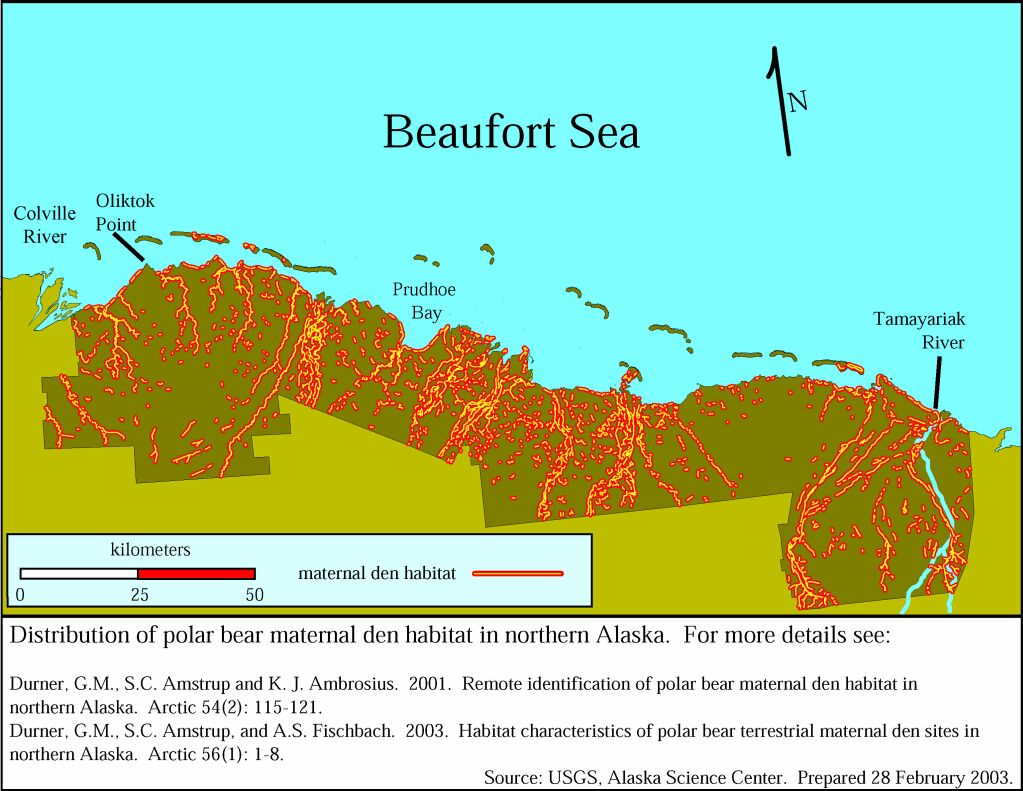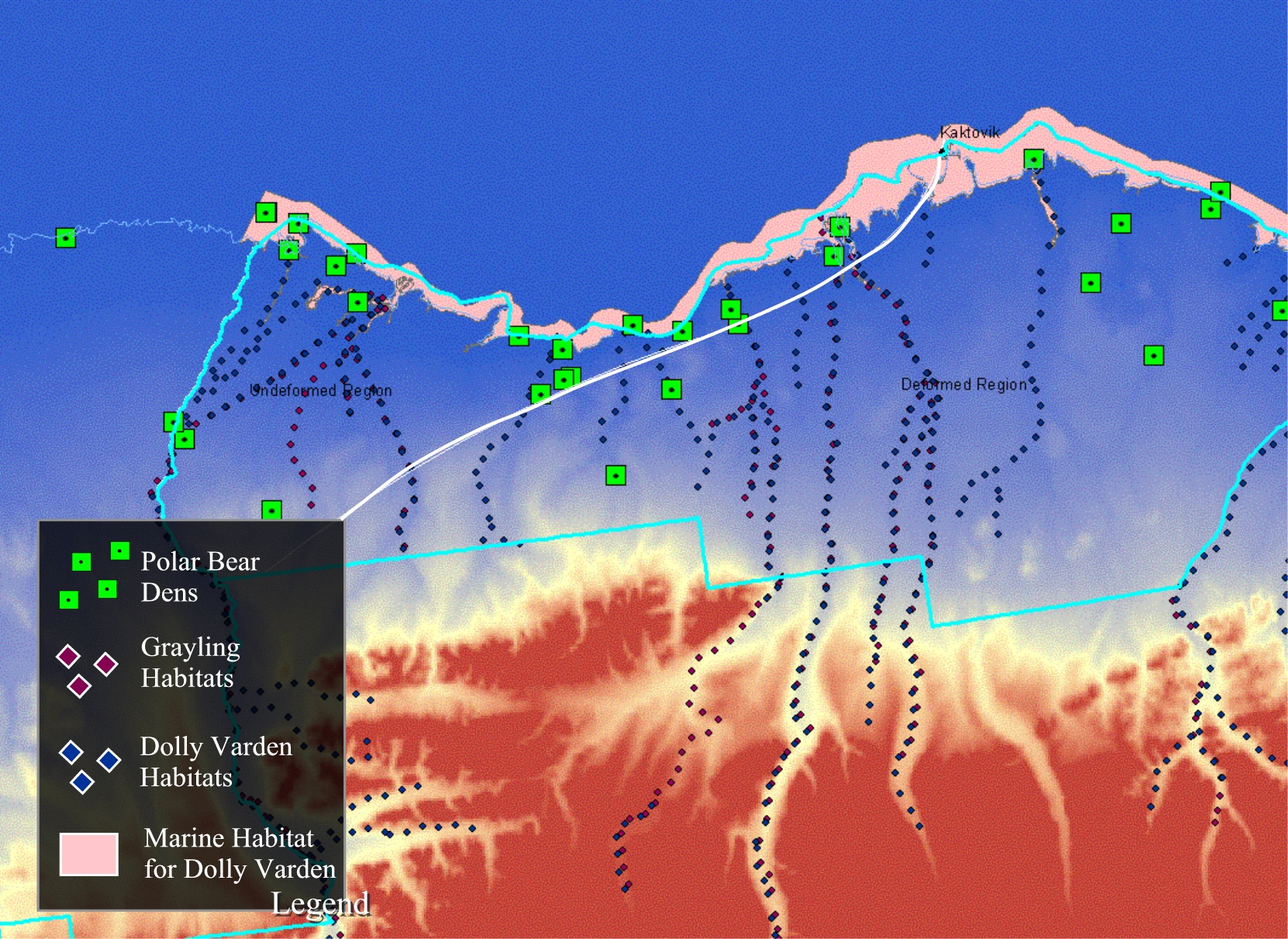Polar Bears (Ursis arctos)

The
Polar Bears in ANWR
Habitat
Polar bears can be found
along the Coastal Plain and on Arctic Ice. Although Polar Bear breeding
occurs on ice, once pregnant, the females migrate to the Coastal Plain in
order to make dens, give birth to and nurse their young. Arctic Refuge's
coastal tundra provides America's only land denning habitat for polar bears,
serving primarily the Beaufort Sea population. It's also one of the world's largest polar bear denning sites (2)
Dangers
- hunted throughout most of their range.
- polar bears of the Beaufort Sea region are exposed to mineral and petroleum
- extraction and related human activities such as shipping,
road-building, and seismic testing (Stirling 1990).
Movement
- Polar bears were observed to move more than 4 km/hr for extended periods, but mean hourly rates of movement varied from 0.30-0.96 km/hr.
- Movement rates varied significantly among months: they generally were lowest
- in spring and late summer and highest in early winter (Amstrup 1995, Amstrup. Geographic displacements from the beginning to the end
of each month were smaller for females with cubs of the year than for single
females, and larger in November than in April.
- Total annual movements ranged from 1,454-6,203 km. Bears that spent
part of the year in dens moved less than others, but non-denning classes of
bears did not differ in total annual movement (Amstrup 1995, Amstrup et al.
2000).
- Beaufort Sea polar bears kept their movements within boundaries
outside of which they seldom ventured. Annual activity areas ranged from 12,730
km2 to 596,800 km2. Monthly activity areas ranged from a mean of 344 km2 for
females with cubs in April to 11,926 km2 for females with yearlings in
December (Amstrup 1995, Amstrup et al. 2000).
Polar Bear Denning Sites:

Breeding
-Amstrup et al. (2001) and McDonald and Amstrup (2001) suggested that
the number of polar bears in the Southern Beaufort Sea population grew at
more than 3% per year between 1967 and 1998, reaching an estimated
population that could be as high as 2,500 animals.
-Survival of adults, as calculated from life tables, was higher and
survival of young lower when the population was large. Survival rates of adult
Beaufort Sea polar bears, however, were as high or higher than those measured
anywhere else.
-Although numbers of young produced per female when the population
was small (<0.40) and when it was large (<0.38) were similar, litters of
more than one yearling were more frequent when the population was small.
Death
-In this study hunting explained 85% of the documented deaths of adult female polar bears (Amstrup and Durner 1995). Natural mortalities were not commonly
observed among prime age animals (Amstrup and Nielsen 1989), and we still know little about the proximate causes of natural deaths among polar bears.
Critical Time Periods:
In
research conducted on the Beaufort Sea Region, it was discovered that in the months of May through August the bears shifted locations to the north and remained there till October.
Sensitivities:
Although hydrocarbons have serious ramifications on all wildlife, polar bears
reproduction rates and rapid growth will not be severely altered if oil is to be
extracted (Amstrup et al. 1989) as can be seen in prior cases. The available
data suggests that polar bears are pretty resilient to environmental
disturbances (Amstrup 1993).

Effects of Petroleum on Polar Bears
- Although contact with hydrocarbons can have serious ramifications for polar
bears (Amstrup et al. 1989), the polar bear's apparent rapid population growth has spanned the entire history of petroleum development in arctic Alaska
(Amstrup 2000, Amstrup et al. 2001, McDonald and Amstrup 2001). This suggests that managed resource development can be compatible with healthy polar bear
populations. Also encouraging is the new ability to estimate potential impacts that oil spills may have on polar bears. That ability has major ramifications
for assessing risks of a variety of potential developments (Durner et al. 2001b).
- Effects of the increasing human intrusions into the polar bear environment have not been
observed at a population level, suggesting that proactive management can assure coexistence of polar bears and human developments.
Endangered?
- Estimated numbers of bears at the close of the study were relatively large.
Early estimates suggested the additional loss of as few as 30 bears each year might push the total take from the population to the maximum sustained yield
(Amstrup et al 1986, Amstrup and DeMaster 1988). Excess take did precipitate a decline in the 1960s and 1970s. Hence, although populations may now be near
historic highs, managers must be alert to possible changes in human activities, including hunting and habitat alterations that could precipitate
future declines.
- because polar bears have a low rate of reproduction and a greater success of
cubbing in land-based dens, onshore denning habitat is crucial to the survival of the species. (2)
References
(1) http://www.absc.usgs.gov/1002/section8.htm
(2) http://www.savealaska.com/sa_anwr.html
(3) Map on polar bear dens and fish habitats created from GIS information from US Fish and Wildlife Services

